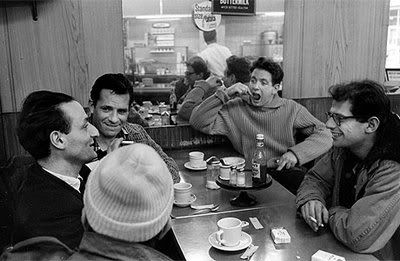Shows Kerouac with a group of close friends at an undisclosed New York diner. The group features Allen Ginsberg, far right; Greg Corso, who is only represented via the back of his head; David Amram, who has his mouth open (Amram is a musician who frequently collaborated w. Kerouac and who was involved in the film project Pull My Daisy); and - most interestingly - New York School painter and poet, Larry Rivers, seen in profile, wearing a suit (as the only one present)...Rivers' uncle was Joe Grossberg who married my great aunt Ida. That and a token....
This photo, and several others from the same day (in connection with the shooting of the film Pull My Daisy) was taken by John Cohen
about Rivers from wikipedia
August 17, 1923 - August 14, 2002) was a Jewish American artist, musician, filmmaker and occasional actor. Rivers resided and maintained studios in New York City, Southampton, New York on (Long Island) and Zihuatanejo, Mexico.
Larry Rivers was born in the Bronx, New York as Yitzhok Loiza Grossberg. He changed his name to Larry Rivers in 1940, after being introduced as "Larry Rivers and the Mudcats" at a local New York City pub. From 1940-45 he worked as a jazz saxophonist in New York City, and he studied at the Juilliard School of Music in 1945-46, along with Miles Davis, with whom he remained friends until Davis's death in 1991.
Rivers is considered by many scholars to be the "Godfather" and "Grand Father" of Pop art, because he was one of the first artists to really merge non-objective, non-narrative art with narrative and objective abstraction.
Rivers took up painting in 1945 and studied at the Hans Hofmann School from 1947-48, and then at New York University. He was a pop artist of the New York School, reproducing everyday objects of American popular culture as art.
During the early 1960s Rivers lived in the Hotel Chelsea notable for its artistic residents like Bob Dylan, Janis Joplin, Leonard Cohen, Arthur C. Clarke, Dylan Thomas, Sid Vicious and multiple people associated with Andy Warhol's Factory. In 1965 he had his first comprehensive retrospective in five important American museums. His final work for the exhibition was The History of the Russian Revolution, which was later on extended permanent display at the Hirshhorn Museum and Sculpture Garden in Washington, DC. During 1967 he was in London collaborating with the American painter Howard Kanovitz.
In 1968, Rivers traveled to Africa for a second time with Pierre Dominique Gaisseau to finish their documentary, Africa and I, they narrowly escaped execution as suspected mercenaries.
During the 1970s he worked closely with Diana Molinari and Michel Auder on many video tape projects, including the infamous Tits, and also worked in neon.
Established as one of America's most important postwar artists, Rivers continued, until his death on 14 August 2002, to exhibit regularly both in the United States and abroad and to create work that combined realistically rendered images within a loosely brushed, quasi-abstract background. His primary gallery being the Marlborough Gallery in New York City. In 2002 a major retrospective of Rivers' work was held at the Corcoran Gallery of Art in Washington, D.C.



























No comments:
Post a Comment